Right now, a very low-key bit of industrial action on the part of a train operator means it's very hard to run charter trains. It has already been a tough summer with rolling stock commandeered for Olympic additionals but in effect sitting idle - bought and paid for of course. This, along with a general ban for steam in London and some stringent restrictions on using the area for other tours, has made the summer a quiet one. However, there was a bit of a renaissance on the cards - three tours in three weeks heading for extremities of the network, visiting the unvisited. In the end? All three cancelled due to the work-to-rule. Already pinched tour promoters pushed closer to the edge. The effect on me? A series of stays in cities far and wide. First Glasgow - never a problem - but this week, Doncaster. This was tougher. With a troubled heart and a lack of enthusiasm I found myself looking for something - indeed anything to escape. Thus I found myself on an early train to Kings Cross today. It was busy. Full of Paralympic spectators. All union flags and enthusiasm. Some had their Team GB attired already, others talked excitedly of how they'd buy into the games. I plugged in and switched off. This was a means to an end.
On getting to London, I persuaded myself that heading east was insane. Dug out my notebook, got a very big bucket of coffee and let the atmosphere of bustle wash over me. After Doncaster it was a relief, but it was turning into a beautiful day and I felt a drag to the water. There could be no harm in checking surely? Onto a 205 - empty, almost weirdly so. I hopped off at Bow Station - the road was quiet. An empty train to Bromley-by-Bow, and aside from shoppers and locals, still nothing. As I surfaced beside the familiar strip of road I could see the floodlights of the park shining beyond the Orbit, but aside from the roar of the Blackwall Tunnel Approach it remained quiet. Encouraged - and oddly excited now to be here - I headed along the road searching for a way down to Bow Locks, convinced that I couldn't gain access through Three Mills. After scuffling along the carriageway I found an entrance through a yard, arriving alongside the mouth of the Limehouse Cut which had nominally become my target for the day. However, I wanted to explore the area first and struck out towards Three Mills on the narrow strip of land between the Lee Navigation and Bow Creek. It was now a bright, hot midday and joggers and cyclists were out in considerable force. Huffing past me, mildly scornful of my shamble, managing to look sleek and healthy despite their discomfort. Passing under the railway, I noted that the path wasn't blocked at Three Mills so headed up to the cafe. It was silent and empty. I chatted briefly and found more dismay at the Olympic. It had ruined the summer. The mill struggled on, just, and they wouldn't be too critical. There was a sense that you just don't talk about it. You swallow the effects of the games, because so many people will tell you to "lighten up" or "be patriotic". I voiced my support and left - the guide lazily explaining the history of the House Mill to a group of tourists as I passed.
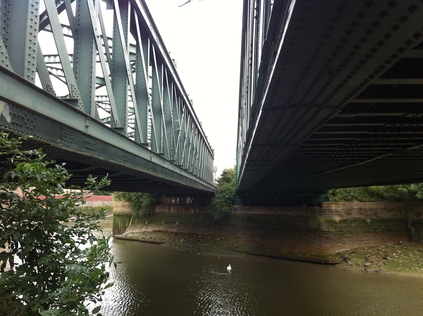
Back to Bow Locks, I struck out along the floating towpath at the opening of the Limehouse Cut. This innovative way of making the canal accessible won awards and was highly regarded, but I still foolishly felt mildly concerned about walking it. It took the tow path around the initial curve of the canal where there had apparently not being a route - at least not for some time. This initial turn to the west led into the long, straight section of the canal. Despite being a fairly featureless section of waterway, the walk was interesting for it's variation. At the Bow end it is derelict industry. Vast premises given over to community use. In one, a gospel group practised loudly, with a drummer banging out a rock rhythm to guide them. Affordable housing surrounded a park to the south - the mingling smells of Asian cooking and Sunday lunch providing a weird olfactory impression of multiculturalism. Beside the path, a rucksack carrying man stood. Looking into the water, a can of Special Brew in hand. He didn't react to my passing at all. I pushed on, under the DLR bridge. From the next access a bunch of Spanish tourists skipped down onto the path and began to shout and jump around. I must have given them a scornful look because they turned their attention to me. Following close behind, aping my ungainly walk and capering like court jesters in front of me. It was harmless but irritating. Eventually a group of fishermen they passed took issue in broad, Anglo Saxon terms. It was unclear if the fishermen should be here either, but they assert this uncertain right in definite terms.
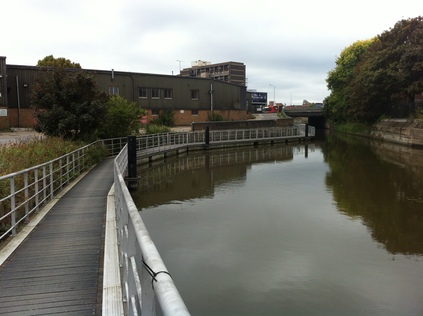
Here I saw the first of the Olympic Water Taxis. Black and silver boats, fitted out with luxurious seats. These must be pre-booked it seems and they putter up the canal towards the Park to order - extortionate fee paid. The Cut curved again at this end, above me Commercial Road roared and the tower of St.Anne's Limehouse was visible. I resisted the urge to surface and pressed on towards the Basin. The scenery changed - redevelopment has been kind to this zone. Luxury waterfront dwellings line the canal, extending out into the basin to form a ring of high-spec flats around the basin - now a marina. I walked over the swing bridge and found the Thames just as it swung south around the Isle of Dogs. The day had turned gloomy and heavy, and a mist hung low over Canada Tower. Across the entrance to the Basin, a pub did a fine trade. I pressed on, circling the basin and taking the Regents Canal entrance under a very narrow bridge. I had half a thought to walk back to Kings Cross, but fatigue and time made me re-evaluate this plan. Instead I decided to follow the canal to where my last walk began at Mile End Road. The sun had returned and the path was busy with cyclists again as I passed through the wilder, southern section of the linear park. A lone brick chimney stood beside the path while on the other bank the scene shifted from housing to derelict industrial scenes and back with surprising regularity. Finally I found the access steps I'd used before and made my way back up to street level. This emergence always seems vaguely surprising and loud, and it took a while to adjust to the roar of traffic. I hopped on a bus back to the city - to expensive coffee and bookshop visits, to a pleasantly quiet train ride back to my northern bolthole.
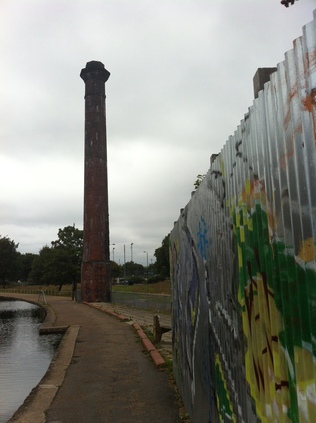
I'd not intended to be here today - to walk this route whilst the Games continued felt impossibly silly. But I've encountered peace and quiet, perhaps eerily so. People are staying or escaping elsewhere. The Olympic effect in London isn't energising or uplifting, it is pushing down on life, squeezing it back into the suburbs. I'm glad in that sense I experienced this. Its not what I expected - and not what we're being sold officially. I hope the House Mill struggles on, that trade picks up. I hope that the illegal fishermen of the Cut are left unhindered by tourists. This world within a city is precious and strange, and I feel rather privileged to have walked it today.
You can see more pictures from the walk here. As an experiment, you can also follow the route on the map below - the blue line is the walking route.
View Limehouse Cut Walk in a larger map
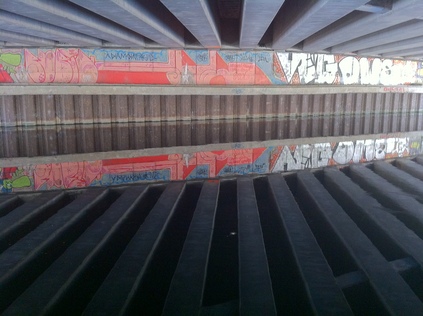
From Hackney Wick to Leyton - An Intra-Games Walk
Posted in London on Saturday 18th August 2012 at 11:08pm
After the widely acclaimed and nominally successful staging of the Olympic Games, London has returned to a sort of strangely pensive calm. Everyone senses the Paralympics will bring a little of the magic back, but no-one really expects them to cause quite the upheaval in terms of the capital's life. Nevertheless, they want to cling to the moment - maintain a bit of the atmosphere of timelessness that the ancient tradition made modern can create. Perhaps that's wrong, and the Paralympics should cause an equivalent stir of pride and celebration? Or maybe there is in fact an honesty and purity in the feats of humanity unbound and in the sporting focus of the Paralympics - at least in comparison to the media circus of the Olympiad? In any case, I'd decided to waste no time in revisiting London, and in trying to connect with the post-Games mood. I didn't really know what to expect - and in many ways, today was a string of strangely unsatisfactory events somehow tumbling together. Such is London life, and so too is the story of this strange invasion into the Eastern fringes.
My journey up to London was fractured and feverish. The day was already shaping up to be very hot, and my mind was full of other, foolish and absurd things. It was one of those trips where I looked up and suddenly found myself in the suburbs of the city. After a fairly leisurely breakfast at Paddington I headed for the bus to take the familiar journey east. The city seemed quiet, maybe even a little subdued. The football season was starting again today, and later it would surely be the usual mad whirl? For now though it was incredibly easy to get across town, pausing only to let an eccentric old woman unload endless bags of recycled plastics at Euston, the driver patiently waiting for her multiple trips, scurrying back and forth from the bus. Another intriguing woman joined the bus, a larger-than-life African matriarch in her finery, heading for a wedding. She asked everyone where it was and how far, pointing out the destination in the invitation, and in the new spirit of London which has arisen she was never ignored. I'm not sure anyone other than the driver was much help however. I left the bus at Mile End with a half-formed plan to walk through Mile End Park to reach Roman Road. As I ascended onto the Green Bridge I was hit by a wall of intense heat. I was still struggling with the nagging issues which had dogged my journey up here, but water - specifically the Regents Canal - always soothed things it seemed. I hugged the towpath instead of straying into the landscaped and sustainable areas of parkland. I wanted continuity and industry today, over people and events. Regretfully leaving the park to head onto the street, I made for one of the exhibition spaces I planned to visit. It was closed and locked despite being due to open an hour or more before. Someone was inside, but they were obviously far too cool to let me in, perhaps regarding the exclusion of this absurd sweating, red-faced man as an act of artistic defiance. I left quickly, feeling embarrassed and wondering how to deal with the spare time I'd created? Things have a habit of resolving themselves out here, and as I build an increasingly reliable mental model of the terrain, so I find a new confidence in walking it. So I headed north alongside the canal again, diverting briefly into Victoria Park. It was busy with joggers, boaters, sunbathers and walkers. The park was feeding off the sunlight, and it's glistening, virtuous inhabitants looked with scorn on the fat, sweaty old man peering mawkishly at his 'phone. I moved on swiftly - uncomfortable with civilisation I headed back to the Canal and doubled back to the almost inconsequential junction with the Hertford Union Canal. I'd walked a brief section of this before, but was keen to follow it's path throughout. As it widened into a broad, slow cut so I noticed something bobbing in the water. Once I'd decided it probably wasn't a plastic bag my mouth dried and I wondered with some horror what I'd seen floating at a jagged, unnatural angle to the surface of the water. I edged closer and noted rhythmic pulses of ripples streaming from each corner. My curiosity soon overcame my unease and I was able to make out a moss-covered, green shelled turtle surfacing in the khaki stained waters. It was just about the only life on display, as the park was hidden behind a screen of trees and the roads above seemed quiet, except for the occasional drunken yelp from people lounging outside pubs in baking beer gardens. I tramped the long stretch of water contentedly, pausing to let occasional cyclists pass and to inspect the fascinating flight of locks.

Eventually I reached familiar territory, and decided to press on. The Olympic Park now loomed large beyond the entrance to the canal where it joins the Hackney Cut. Along this stretch a series of miniature, human figurines cast in iron line the water's edge. People were walking towards me so there must be some way through, surely? Over the Cut, the closed Towpath which had first dragged me into this mess of waterways months ago basked mockingly in the sun, unused except by prowling patrols. Forced to ascend from the canal at White Post Lane, I found the fence manned half-heartedly beside an impressively security hardened gateway. An empty police landrover stood by, it's inhabitants unseen. I lingered a while, tried for some pictures, but realised I was attracting the interest of the guards. A lazy sort of interest which was soon distracted by a crowd of lost cyclists and a proper photographer. Backup was called for. It felt like this was the busiest things had been for a while. I sloped off around the corner and found "The Walls Have Ears", a street long mural celebrating the industrial success stories of Hackney Wick, alongside some of the notable local events and snippets of history. I lingered here in the incredible heat, the sunlight reflecting off the dry dusty ground. Eventually distracted by a passing freight train, my trainspotter's eye never quite closed, I headed under the station and into Wick Village. It was fruitless trying to reach the Cut again until the pleasant stretch which edges along the Tenant Managed community. I wasn't sure I was supposed to be here - it was almost deserted. Windows were open and snippets of sound drifted out of the pleasant little homes, many of them decorated colourfully or decked out in flower baskets. Utterly out of character with the shining silvery hulk of the utilitarian end of the Olympic Park just over the water. I stopped to take a picture and a voice was raised from the opposite bank: "Are you OK?". Of course I was. "What are you doing? Why are you taking pictures of me?". I assured the lime-shirted LOCOG guard I wasn't doing any such thing, and turned the tables by asking a few questions about the towpath on which he was standing. He was factual but evasive and said "You can't take pictures here, and you have to leave". I assured him I didn't and despite being initially perplexed, he eventually started to gruffly snuffle into his radio. As I sat on a conveniently shady bench near the Eastway overbridge, within moments the little orange boat left its mooring and started slowly paddling north, and a couple more bodies peeled away from the fence in the distance, and began slowly walking up the towpath...
By the time they reached the guard, I was up on the Eastway bridge. They pointed and shouted, but I was out of range. Initially feeling the triumph of defiance, I realised that it was now midday and I was flagging. I turned east and struck out along the northern fringe of the park, along the edge of the carpark beside the IBC/MPC building. The various accesses were open and active, but well-guarded with a distinct British Army presence. The soldiers were bored and seemed tired of the whole setup. One stopped me to ask if I was lost, and I assured him not. I suggested that sitting out in the sunshine was probably a popular posting today but he grimaced and said "No, it's boring to be honest pal". I asked if he'd managed to get asked in to fill empty seats during the games and he did that thing I've heard so much about from others - that subtle but ultimately firm and direct change of subject designed to dodge all potential PR pitfalls: "How about you? Did you get any tickets?". I left him sprawled in the sun and tried to negotiate the road junction. Here, the A12 is effectively a motorway and Eastway takes a strange mixture of routes onto it, with a branch swinging sharply underneath to emerge as Ruckholt Road. On the map it looked impossible, on the ground it was utter folly. Crossings were closed, paths blocked. Signs removed. I guessed and finally made it across but not without terrifying myself that I couldn't move fast enough. Turning a corner to find the finery and pomp cranked up for the Eton Manor entrance, the painted lanes on the road were a tangled mess of currently inactive Games Lanes where once there had been filter lanes for the various complex left and right turns. It's easy to see how tragic accidents occurred near here - no-one seemed to fully understand even their own path through the complex.
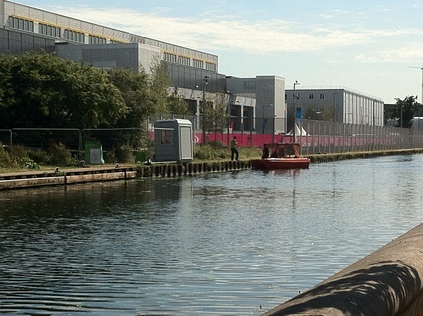
For my own part, I was now in some physical distress. Feeling every year of my age and cursing my weight and sluggishness, the sun was blinding me. I felt woozy and sick. I drank water endlessly, tried to slow my pounding heart and wipe the sweat away but couldn't seem to. A LOCOG car prowled not far from me, keeping pace with my erratic wanderings. Things were quiet enough to deploy individual security now? I wondered if I was sick, was going to collapse here out of the way of humans without cars? I felt like I was trapped in a JG Ballard world as traffic beat a strangely hypnotic rhythm over joints in bridge sections. I pushed on into Waltham Forest, as if crossing the county line would provide the mysterious sanctuary it seemed to offer in all the best films. I'll never know quite how I struggled over the bridge which spans Temple Mills Eurostar depot, which seemed endless and silent. I told myself there would be shade around the next corner, but it never came. Not until I finally careered down the stairs and collapsed into a seat on Leyton Station, the official car at last deserting me and speeding off towards Stratford. No doubt there were sufficient cameras to track my every move from here, I thought - paranoia finally being allowed some room in my racing mind. The train back to Stratford, then Liverpool Street was a blur of people and confusion. It had been a strange morning, but intentionally or otherwise I had covered the ground on this side of the Park which I feared I'd never get to walk and in this respect at least, I'd completed my circumnavigation of the park. Was I any the wiser? Probably not. The scale and complexity of the project still bewildered me, and it's effects on the surrounding communities seemed starker than ever.
I will of course be back. There is a story yet to tell here. One of legacy, of potential futures - maybe even a return to the wilderness for Stratford Marsh if developers cannot be found. For now though I tried to travel backwards in time via a visit to the Clays Lane Archive. That too was closed. I felt shut out and abandoned, and decided to find refreshment and contemplation in a city churchyard. The powerful sun still glaring at six in the evening, and questions still largely unresolved. On my journey home, the weather would get the better of a fractious group of young men on the train too, causing a disturbance and threatening passengers. The uneasy consensus that "everything is fine, we're all happy" which dominated the last few glorious Olympic weeks, is clearly over.
You can see more pictures from the walk here. As an experiment, you can also follow the route on the map below - the blue line is the walking route.
View An Intra-Games Walk in a larger map

The Five Ring Circus Leaves Town - A Facebook Rant...
Posted in London on Tuesday 14th August 2012 at 8:08am
This is something I posted on Facebook, largely in response to some of the negative comments I received following expressing my views on the London Olympics. It's not the post I'd like to have written which details my personal connection with the area, but it goes some way to explaining why I feel how I do about what's happened here over the last several weeks. It should be read as a hurried, rather fractious response to having to stay fairly quiet for a while!
So, it's over...
There have been some emotional moments over the past two weeks - from athletes shedding hard-earned tears of joy and pain on the podium, to people venting their spleen in my inbox! It's been a very strange and uncomfortable time to be an Olympic Sceptic, and I'm aware it's made me come across as more humourless and cantankerous than ever in the process. But was I anti-olympics really? I certainly think there were some amazing displays of endurance, strength, speed and humility - all the values which the Games were founded on. While I'm not a sports fan, and I didn't recognise most of the names which seem to have had everyone on the edge of their seats, I've never, ever commented negatively on Team GB or indeed any of the athletes from any nation. I wouldn't dare to have done - they're all astoundingly good at what they do and maybe the Games will propel a whole new generation of youngsters towards Rio in 2016 too?
My concerns about the Olympics are based essentially on two things - firstly, the big stuff: the whole circus of the bidding process, the role of the IOC and the financial risks to the host city, the security and militarisation which we may never now be rid of etc. Secondly, I'm really concerned about the specific effects on everyday life in a little corner of London - one that struggles and usually survives, but which is genuinely threatened by the 'legacy' if things go off course. I've not idly jumped on a bandwagon here just to be contrary. I've read many, many documents running to thousands of pages and learned a huge amount about democracy, planning and environmental issues. I've tried hard to see both sides and find the benefits among the drawbacks - and of course I recognise that there are benefits, but question where they'll land. I've repeatedly gone out and walked the park and it's environs as far as I've been able over the past seven years, trying to understand its changing role and character - and I'll carry on doing that. I don't do this for any reason other than finding it a fascinating and surprising, if perpetually liminal, place to wander. Not least, I worry a great deal about the acceptance of 'private' public spaces which are not for everyone - and the Park may well become one of these in time.
We may never know the real price tag - and the leaps in cost over time have casually and repeatedly multiplied a figure which was already so big that it was beyond comprehension for most of us. £2bn became £4bn, then £9bn then something closer to £11bn of public finance. This doesn't include the compulsory purchase of lands, remediation of polluted soil, or any contribution to the transport infrastructure or Westfield Shopping Mall. After all, these are being sold as Olympic Benefits! What is certain is that we can't afford this just now. As for Freedom of Information, the Olympic Delivery Authority is not a wholly public body - so we'll never really get the numbers.
The legislation which has entered statute around the Games is a really worrying legacy. It has seen global brands using the law to protect themselves from competition, has seen democratic and local planning processes sidelined, and has seen the individual rights of citizens limited. Today ministers are talking about retaining the relaxed Sunday Trading laws post-Games - in itself probably not a bad thing. But it illustrates how these laws will tend to remain in place, and how the right to walk certain paths, to protest peacefully and to choose which companies you support with your money has been eroded in the name of the London Olympics.
Life around the games was tough for people in Stratford, Hackney Wick, Leyton and Bow - from the start of "Dig, Demolish, Design" in 2007 right up to this morning. I number some of these residents as my friends and correspondents, and they've suffered upheaval with a degree of dignity because many of them thought this was a fantastic, positive expression of British hospitality and sportsmanship. However, it seems only fair then that these communities should share in the prosperity. Largely though, they didn't. They were treated desperately unfairly during the planning and building of the venues, were marginalised during the games, and the danger is that as the Olympic Park is transformed into its post-games state it will form a new, very separate neighbourhood which has nothing to do with the landscape it inhabits. For the people who were evicted from their homes and who saw their jobs moved away from the area though, they will defnintely not get to share in the local legacy of the games. And the term "legacy"? It has been strangely redefined during the games as something you can build in advance rather than something you leave behind. And again yesterday it was being hastily rewritten to focus solely on the sporting and cultural legacies, rather than the bricks and mortar and economic legacies which were a major component of the bid. I'll watch this process with interest over the coming months and years.
Finally the question comes - am I not proud to be British today? The answer is, yes I am - but some of the things I'm proud of are the facts that we can question the decisions of our authorities without fear of reprisals, can express our frustrations and disappointments alongside our triumph, and that we let local people have a say in what happens in their neighbourhoods. All of these things have suffered setbacks since July 2005, and not all of them due to the Olympics. However, it has provided the ultimate rug under which to sweep some pretty dramatic changes in the UK. It's time we stepped back from this mob-culture thing of "if you're not waving a flag you're clearly a terrorist" - it's lazy, dangerous and pretty damn silly.
I probably won't get back the lost Facebook friends and twitter followers - but if you actually know me in real life, none of the above will have surprised you one bit of course!
I'm not a Londoner. Never have been, and it's fairly certain I never will be. My relationship with London is a strange and complicated one - sometimes bordering on reverence, and sometimes borne of a strange distaste. Spurred on by literature and music, snippets of legend and odd coincidences, I've gradually mapped out a city of my own during the last twenty years. This has grown eastwards - from my early timid steps out of Paddington towards the City, then over the boundary and into Spitalfields and Hackney. As my knowledge grew, so did my appetite for the literature and history of the eastern edges of the city. I was hooked, finding untold possibility in every dead end, every scruffy side-turning. Having carefully evaluated this view from safe distances I was sure it wasn't some dreadful middle-class 'slumming' thing. I was genuinely finding myself bound up in the boroughs, and wanting to understand them as best I could.
Today was wet, and as I stepped out of Bow Road Station I was met with a shining roadway and trees dripping dolefully on me. I shouldn't be here. I'd vowed again that I'd made my last trip before the Games, but as the activity and focus intensifies in the press - so does my desire to be here. I've got this horrible feeling that it won't be the same again, that this is the end of things. Perhaps it's melodramatic - but it seems like the end of London. My London at least. But it doesn't feel like it this morning, and the margins of Bow Road are as raggedly familiar as ever - the Ferodo Bridge sheltering me as I tap out messages which scud over the channel to a desperate friend. Everyone is on the edge. Turning into Fairfield Road, the leafy quiet descends. This residential corner of Bow has always felt pleasant and perhaps a little dull from the train above, but here at ground level it's a surprisingly busy walk. People shuffle out of their buildings, taking the chance of a gap in the torrents. Once under the railway bridges - carrying the Great Eastern on its run into Liverpool Street and the little used curve from Bow to Gas Factory Junction - the Lexington Building becomes a dominating presence. The ornate gatehouse signals a former use - Bryant and May's sprawling match factory, site of one of the earliest feminist actions in the 1888 strike organised by Annie Besant. Closed in 1979 and left to languish along with much of this part of the city, it is now Bow Quarter. A gated village which has hosted celebrities on the up, and sometimes on the way down. But my journey here is once again related to the Olympics. On top of one of the startlingly tall, red brick watertowers are surface-to-air missiles. Part of a ring of defences for the Olympic Park which do not offer much in the way of reassurance - if these missiles with their five mile range need to be fired, a plane will fall over the eastern reaches of London with all the attendant misery and horror. There is no assurance in the presence of these weapons at all. I circle the building - there is only a glimpse of the hardware available - a sinister presence on top of the building, capable of dealing death - indirectly - to many thousands. The locals are stirring. A pretty, but stiffly miniskirted young woman swishes along the path under her umbrella, finding my shambling presence a worry and crossing the road quickly. A blonde, rakishly housecoated young man smokes and drinks tea barefoot on his doorstep. It's quiet. No vehicles move except the occasional Tesco or Ocado van, and the relentless stream of 488 buses heading for Bromley. I remind myself that's where I need to head too, and speed up my circuit of the building in search of the photograph which sums it all up. I'll know it when I see it. On Wick Lane, a mad traffic scheme has made it hugely difficult for pedestrians, and under the railway bridge it is blocked by a works compound. There is no way to double back through Bow Quarter so I'm forced to retrace my steps. As I pass the gatehouse, two figures silently emerge - both uniformed, one in the olive green of the British Army. My lurking has not gone unnoticed and I have questions to answer.
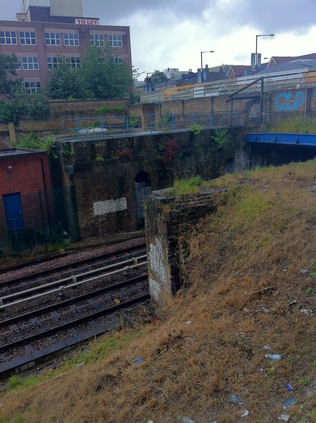
The light-touch interrogators claimed my presence had "upset the residents". I bit my tongue, thinking how theirs had probably in fact caused far more upset. But I'm allowed to leave unmolested with a suggestion that I avoid the area until September 14th on pain of arrest. There's no paperwork, no proof of the injunction. This is instant service, delivered without a smile. I'll have little choice of course. But I'm late for my meeting with a friend, so I plough on into the rain, back to Bow Road and across into the quiet centre of Bromley. I follow estate paths and quiet residential roads. Families scuff quietly through the rain, snakes of children dawdling, either idly ignorant or indifferent to the changing face of their locale. I come upon the station from the north, and red faced, breathing hard and feeling distinctly old I meet my friend who has agreed to join me for a walk around some of my recent trails. I relate the morning's tale to her amusement, and we head out of the station, alongisde the Blackwall Tunnel Approach road and into Three Mills Lane. We talk about how she is now a Londoner and wants to see the city - all of it. She can circuit Buckingham Palace on her bus to the station, but it's these wanders into the unknown which interest her. I retrace recent steps, wondering just how much of the walk I'll be able to achieve post Lockdown. Our first taste of the Games comes just on the edge of Three Mills - the towpath south of here is closed, the swollen mouth of Bow Creek off limits. Tour groups shuffle damply behind their leaders, still being told there is no means of entry to the Park but that they can see the sights. I wonder where and how, given the route these opportunistic guides have been taking is now severed? Avoiding the groups we wander onto Three Mills Green, the new wholesomely crunchy pathways under puddles of water after the last few weeks of rain. The lock on Prescott Channel is silent, the bridge to Abbey Mills closed. My friend spies the building and is transfixed by it. We'll get there I promise, silently wondering if we can? Skirting the park we cross Three Mills Wall river and take to the streets. My friend remarks how quiet it is, and how it could be 'anywhere'. The calm streets of current and former council properties seem immune to the events just a short walk away across Stratford High Street. The rain starts to sheet horizontally across us. Visibility diminishes. We struggle up the slippery wooden steps onto the Greenway and find a vantage point where the vast temple of the Pumping Station can be appreciated. Its strangely eastern influences seem out of place in the misty, drizzly air. The chimney stumps, inert since 1941, look sinister and squat. Ahead of us Channelsea House towers, apparently unaffected by regeneration and near abandoned. We turn and walk towards the Olympic Park, the increasingly irritating Orbit structure dominating the skyline. The temporary bridge remains defended by razor wire, so we edge down to the crossing then work back towards Stratford. Warton Road is closed to cyclists and pedestrians, so we turn into the Carpenters Road Estate. I get a sudden, amusing realisation that all those railway junction names which seem so exotic and unknown when plotting unusual routes represent this topography. Carpenters Road Junction to Channelsea Junction - and there is on the map at least - a watercourse between the estate and the railway, a ghost of the buried Channelsea River? If so, it is now entirely gone. Culverted in 1958, the river has a legendary past linking it back to Alfred the Great. There is no way through for us though, great iron gates claiming we're "Welcome to London 2012". I've never felt less welcome.
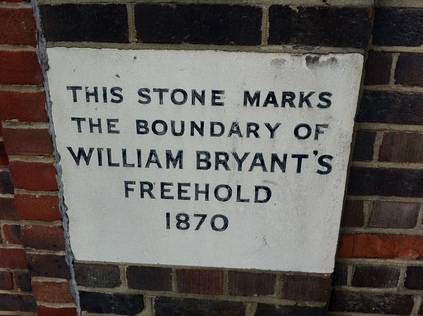
We follow shoppers over the footbridge, descending at Stratford Station. The tide heading for Westfield is a shadow of that sunny Saturday throng I witnessed just a couple of weeks back. The rain, and the threat of exceptional crowds holding them back perhaps. We head over the rust-coloured bridge, pausing to look at the park. "It's horrible, from here at least" my friend remarks. It's her city, not mine - but usually I'd have felt that pang of defensiveness. There's nothing there though, and I agree with her wholeheartedly. We head into Westfield and find a pub where we can catch up properly - The Cow is a strange effort - a glass and metal shed on the edge of the shopping centre, looking out over the Stratford Gate to the Olympic Park. Inside, the exposed utilities are accompanied by amusingly silly wooden beams and lots of bovine memorabilia and signage. Drinks are expensive, but the staff are surprisingly polite. Throughout our conversation, I keep returning to the Olympics - perhaps people are right, and I am obsessed? I mention the fence again and again, it troubles me - haunts my walks, offends my eyes. I explain the lineage of my concerns - from reading early, worrying accounts of what would occur here, through endless crossings and recrossings of the park by rail, and eventually on foot while I still could. An urgency caused by the increasingly draconian attempts to render the park inaccessible. We touch on radioactivity, Clays Lane, the allotments, football pitches. All the old arguments rehearsed again. I try to pitch the difference between wilderness and wasteland. I have a sympathetic audience, but it's all too late. It still feels like the end of London. After we part at Stratford Station, I walk to the edge of the Westfield site. Over the fence near the International Station, groups of children are practicing for the Opening Ceremony in the precincts of the Athlete's Village. The fence is a presence even here. I dare not linger, and catch the driverless DLR train to Stratford, curving through the park, the alignment following old curves of railway lines then dipping under the buildings. At Stratford I change to the older DLR line which uses part of the railway which cuts north-south through Bow and takes me back to my starting point. On route, we linger at the closed Pudding Mill Lane station waiting for the line to clear. In the midst of the Olympic Park, this is a deleted station. Beside us, the piers of it's replacement are half made, work on Crossrail abandoned until after the event. London is on pause. Waiting. I alight at Bow Church and ascend to the street just feet from the end of Fairfield Road, where I began the strangely frustrating journey today. Blocked at every turn, but oddly I want to walk these streets more than ever now. I want to explore every possible route through this complex and ancient district. I desperately want to come back.
Even at Paddington, the Games dominate proceedings. The Mayor's voice - ill-suited to public announcements - lisps and quacks through his urge to travel differently. Pink signs point the way to the park like it's just around the corner rather than a city away, greeters stand idly on the Heathrow Express platforms waiting for athletes and media representatives to arrive. Beside the exit, a new tunnel has opened to provide access to transport for Games officials. I can't remember this passageway before, and any hope of exploring is scuppered by security guards. On the way home, I flick through reports about the Army presence. Anyone who'd walked the area knew they were here weeks ago, and now they're here in remarkable numbers. G4S get the blame for falling short, but it feels like the military were always coming and this is just a great excuse to explain it to the public. And its these things - disingenuous accounts, towpaths suddenly closed, pedestrians banned - which make me wonder if we'll ever get any of this back? Will the towpath along the Lea ever be walkable again? Will the soldiers ever leave the area completely? It's for these reasons that this feels like an ending - like London won't ever be the same post-Games. Looking west from the 205 bus, there is a hint of sunshine on the horizon, but back east it's black and ominous.
Lost::MikeGTN
I've had a home on the web for more years than I care to remember, and a few kind souls persuade me it's worth persisting with keeping it updated. This current incarnation of the site is centred around the blog posts which began back in 1999 as 'the daylog' and continued through my travels and tribulations during the following years.
I don't get out and about nearly as much these days, but I do try to record significant events and trips for posterity. You may also have arrived here by following the trail to my former music blog Songs Heard On Fast Trains. That content is preserved here too.



